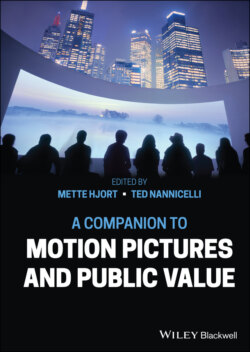Читать книгу A Companion to Motion Pictures and Public Value - Группа авторов - Страница 44
Mediated Appreciation
ОглавлениеTo begin, let me further explain the aforementioned notion of mediated appreciation.4 This is familiar to all of us from our experience with everyday photographs: by looking at a photograph, it seems that we can appreciate the subject of the photograph. For example, we can appreciate Cary Grant’s handsome features through looking at certain photographs of him. It may be true that these photographs themselves are nice-looking images, but it’s also true that Grant, the man, was nice-looking, and though you may never have met him, you can come to that assessment by looking at photos of him. Such aesthetic appreciation of Grant’s features is mediated by—it takes place through—viewing these images. Let us say that a representation of an object that, through our experience of it, allows us to thereby appreciate that object is appreciatively apt for it. Being appreciatively apt, we should note, is a matter of degree: a color photo of Grant would be more appreciatively apt for his looks than a black and white one.5
That photographs of people and everyday objects can be appreciatively apt seems clear. But what about representations of other things? Consider art: just as we use photographs to appreciate people’s looks, so we also use them to appreciate works of art. A photograph of Degas’ L’Etoile is different from, and does not fully substitute for, the artwork in the Louvre: the size is obviously different, for example; the texture of the paint and the brushstrokes may not be evident in the photograph; and the glossy sheen of a photographic reproduction is not a property of the original canvas. Nonetheless, reproductions do present to us many of the work’s features, such as the composition of shapes and colors on the canvas, and we can appreciate the work’s aesthetic achievement, to some degree, on that basis. Another familiar example of appreciating art in a mediated way is listening to a recording of a live vocal performance: the recording presents to us some of the relevant qualities of the performance, and thereby allows us to appreciate it (again, to some degree) without directly perceiving it (Semczyszyn 2013b).
These cases of mediated appreciation of artworks are familiar and commonplace, and they do play an important role in our appreciation of art. Our culture’s aesthetic appreciation of painting would be very different, were it not for the existence of photographic reproduction. Nonetheless, mediated appreciation seems to have only a secondary importance in the appreciation of art. Direct perceptual experience remains the paradigm, with reproductions being used only for convenience, and themselves raising no theoretical puzzles.
In the case of mediated appreciation of nature, however, we find matters somewhat inverted. Here mediated experience plays a much more central role than it does in our appreciation of art: most of us have never seen, or will ever see, a polar bear in its Arctic habitat, the Great Barrier Reef, or a Sahara desert landscape. If we have any aesthetic access to these at all, it is an access mediated via representations such as photos, paintings, film, and literary narratives. Indeed, there are some parts of nature that can only be appreciated through representations, for practical or prudential reasons, such as the ocean floor and the far side of the moon.
Ecological considerations can also confer particular importance on mediated nature appreciation. Consider Sable Island: a remote sandy strip of land about 300 km off the eastern shore of Canada. It’s a striking landscape with a unique natural history and a fragile ecology: a 40-kilometer-long sandbar whose dunes, continually blasted by the winds of the North Atlantic, are held together by vegetation. Until recently, access to the island was restricted by the Canadian government, since trampling of the island’s native grasses poses a threat to dune stability and hence the very existence of the island. To the extent that anyone knew the beauty of the place at all, it was through photographs and films, such as those created in the 1990s by the photographer Roberto Dutesco, who obtained permission to visit the island and photograph its population of wild horses. In cases such as this, direct appreciation would come at a real environmental cost (for more on this case, see Parsons 2015).
But though mediated appreciation is arguably central to our appreciation of nature, in a way it is not central to our appreciation of art, it has often been viewed with suspicion, if not hostility, by philosophers interested in natural beauty. So let me now turn to those philosophers and their suspicions.
